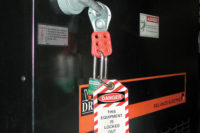When machine guards are missing in action

Citations: 2,831
Inspections: 2,418
Penalties: $9,120,642
Most penalized industries:
1 Fabricated Metal Product Manufacturing - $2,881,817
2 Plastics and Rubber Products Manufacturing - $1,231,845
3 Food Manufacturing - $729,373
4 Machinery Manufacturing - $537,270
5 Transportation Equipment Manufacturing - $453,170
6 Paper Manufacturing - $305,158
7 Merchant Wholesalers, Durable Goods - $274,644
8 Wood Product Manufacturing - $263,009
9 Printing and Related Support Activities - $188,159
10 Chemical Manufacturing - $159,130
Three most specific industries penalized:
• Plate Work and Fabricated Structural Product Mfg - $377,808
• Machine shops - $338,759
• Spring and Wire Product Mfg - $334,603
The Big 3 dangerous machines:
SAWS
OSHA states that serious injuries can result from the use of portable and stationary power saws. Accidents may occur if the operator is inexperienced, improperly trained or if the blade is not properly guarded. Dangerous saws include table saws, band saws, radial saws, chop saws, miter saws, and handheld saws, according to OSHA.
According to estimates made by the Consumer Product Safety Commission, more than 310,000 injuries involving workshop power tools required medical attention in the United States in 1995. About one-third (87,000) of these injuries were associated with power saws, both portable and stationary.
OSHA says the easiest way to avoid injury is to use properly guarded saws and appropriate safety equipment. Avoid loose-fitting clothes and long hair that might become entangled in a power tool and remove rings, watches, neck chains and other jewelry.
PRESSES
Bureau of Labor Statistics (BLS) data indicate that approximately three-fifths of all work related amputations involved a worker’s finger or arm getting caught or compressed by a piece of machinery such as a press or conveyer (BLS, 1997). Injury statistics compiled by OSHA indicated that 49 percent of the injuries from mechanical power presses resulted in an amputation.
Power presses are used to work on metal or other material with cutting, shaping, or combination dies attached to plungers, platens, or slides (rams). A press consists of a stationary bed or anvil, and a slide. The slide has a controlled reciprocating motion toward and away from the bed surface and at right angles to it. It is guided in the frame of the machine to give a definite path of motion. Power presses are used in a wide variety of industries to punch, shear, and form metal and other materials.
The types of power presses covered in OSHA’s eTraining Tool for Machine Guards include mechanical power presses, hydraulic presses, powered press brakes and pneumatic presses.
PLASTICS MACHINERY
Plastics processing machines are complex pieces of equipment (such as horizontal injection molding machines and thermoforming machines) that require guards to protect employees from nip points, numerous moving parts, and exposure to high voltage and high temperature. Serious injuries including fatalities, amputations, avulsions, burns, cuts, and bruises can occur during operation, according to OSHA. Such injuries may result from guards that are missing, improperly installed, removed, or bypassed.
Looking for a reprint of this article?
From high-res PDFs to custom plaques, order your copy today!





